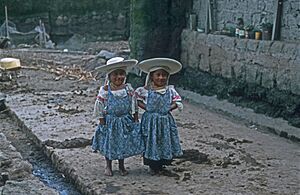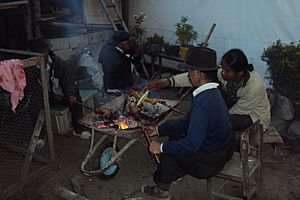Otavalo people facts for kids

Otavalo girl in traditional clothing
|
|
| Regions with significant populations | |
|---|---|
| Ecuador | |
| Languages | |
| Kichwa, Spanish | |
| Religion | |
| Catholicism Andean Cosmovision | |
| Related ethnic groups | |
| Other Andean peoples of Ecuador |
The Otavalos are an indigenous group from the Andean mountains in northern Ecuador. They live in the Imbabura Province, including the city of Otavalo. The Otavalos are well-known for their trade and beautiful handmade crafts. They often have a better standard of living than many other native groups and people of mixed heritage in their area.
The Otavalo people live high up in the cool Andes mountains. The city of Otavalo is about 2,532 meters (8,307 feet) above sea level.

Contents
History of the Otavalo People

Before the Inca Empire took over in the late 1400s or early 1500s, the area north of Quito was home to several small groups. These included the Otavalo, Caranqui, Cayambe, and Cochasquí peoples. They were similar in their art, how they got food, how they built homes, and likely spoke Barbacoan languages. About 100,000 to 180,000 people lived in these groups before the Incas arrived.
The Otavalo and other Andean people in northern Ecuador are often linked to ancient groups. These include the pre-Columbian Cara people and the Quitu culture. The capital city of Quito gets its name from the Quitu people.
Farming and Trade in Ancient Times
The Otavalo area was very populated. The Otavalo people were skilled farmers. They used irrigation and built special raised fields called Waru Waru to control water for their crops. Important crops included corn, potatoes, and at lower, warmer places, coca. Domesticated guinea pigs were a key source of meat. They also hunted wild animals like deer. Unlike people further south, the Otavalo did not have domesticated llamas or alpacas before the Incas.
The short time the Incas ruled did not change Otavalo culture much. The Incas usually moved people around, but few were moved into the Otavalo region. Also, the Otavalos had special long-distance traders called mindaláes. These traders continued to work outside the control of the local chiefs. They traded with people living on the western slopes of the Andes, especially in the Mira River valley. They brought goods like cotton, coca, salt, and dried fish from the Pacific coast to the highlands.
Spanish Rule and Changes
The Spanish took over the Inca Empire in the 1530s. Spanish settlers then began to arrive. The Spanish conquest and rule, along with new European diseases, greatly affected the Otavalo people. By 1582, the population in northern Ecuador had dropped by about 80 percent to only 30,000 people.
The Spanish made the Otavalo people work very hard. One-fifth of the Otavalo were forced to work for the Spanish, almost like slaves. They often worked in hot, tropical areas they were not used to. The work was very difficult and dangerous.
The Otavalo Today
Unlike many other groups, the Otavalo survived as a distinct people. However, after the 1500s, they stopped speaking their original language. They now speak Kichwa, which is the Quechua language spoken in Ecuador, and Spanish.
In 1990, there were an estimated 45,000 to 50,000 Otavalo people in their home area. Another 5,000 to 8,000 lived in other parts of Ecuador or in other countries.
Economy and Lifestyle
Most Otavalo people are farmers who grow crops like potatoes and raise animals. Many also work in the textile industry. They create beautiful traditional Otavalo-style fabrics, often woven from alpaca or llama wool. Many of these textiles are sold to other countries, like those in North America. Some Otavalo people are business owners who run these textile companies.
Tourism is also a big part of their economy. Visitors are drawn to the area because of the Otavalo's unique culture and traditional clothing.
See also
 In Spanish: Kichwa Otavalo para niños
In Spanish: Kichwa Otavalo para niños

